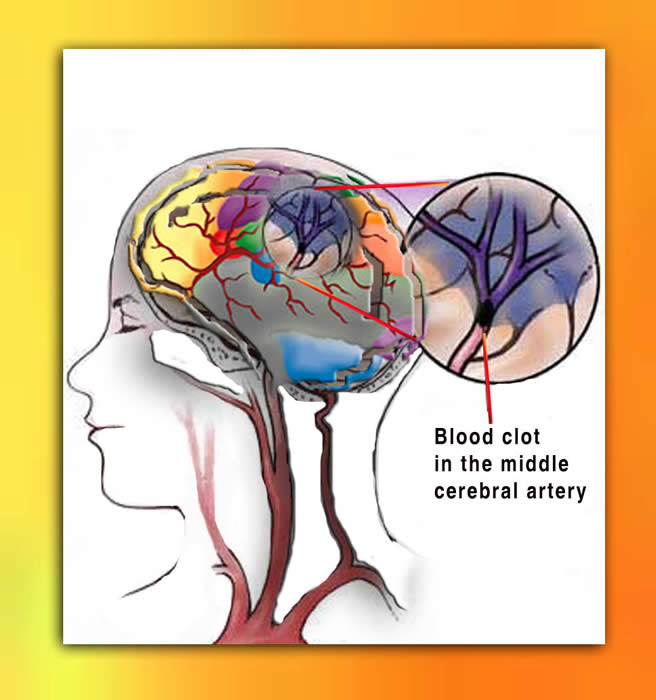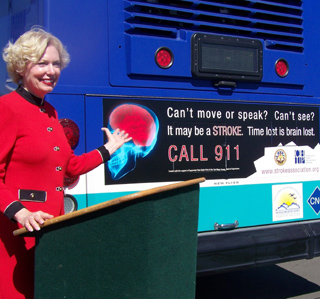IMPORTANT INFORMATION THAT MAY SAVE YOUR LIFE |
|||||
STROKE |
|||||
by United States National Institutes of Health (NIH), The American Heart Association and The County of San Diego Stroke is the third leading cause of death in the United States and a leading cause of serious, long-term disability in adults. About 600,000 new strokes are reported in the U.S. each year. Nearly three-quarters of What is a stroke? A stroke, sometimes called a "brain attack," occurs when blood flow to the brain is interrupted. When a stroke occurs, brain cells in the immediate area begin to die because they stop getting the oxygen and nutrients they need to function. There are two major kinds of stroke. The first, called an ischemic stroke, is caused by a blood clot that blocks or plugs a blood vessel or artery in the brain. About 80 percent of all strokes are ischemic. The second, known as a hemorrhagic stroke, is caused by a blood vessel in the brain that breaks and bleeds into the brain. About 20 percent of strokes are hemorrhagic. What disabilities can result from a stroke? Although stroke is a disease of the brain, it can affect the entire body. The effects of a stroke range from mild to severe and can include paralysis, problems with thinking, problems with speaking, and emotional problems. Patients may also experience pain or numbness after a stroke. Know the warning signs • Because stroke injures the brain, you may not realize that you are having a stroke. To a bystander, someone having a stroke may just look unaware or confused. Stroke victims have the best chance if someone around them recognizes the symptoms and acts quickly. • People need to understand the importance of calling 9-1-1if they experience the symptoms of stroke. Stroke symptoms are not necessarily painful, the warning signs often go unrecognized and people frequently do not seek emergency treatment. Immediate medical attention can make the difference between life or death and in the quality of life for a stroke survivor. What are the symptoms of a stroke? The symptoms of stroke are distinct because they happen quickly: • Sudden numbness or weakness of the face, arm, or leg (especially on one side of the body) Call 911 immediately if you or someone around you has the mentioned symptoms. Because stroke injures the brain, you may not realize that you are having a stroke. The people around you might not know it either. Your family, friends, or neighbors may think you are confused. You may not be able to call 911 on your own. That's why everyone should know the signs of stroke - and know how to act fast. Don't wait for the symptoms to improve or worsen. If you believe you are having a stroke - or someone you know is having a stroke - call 911 immediately. Making the decision to call for medical help can make the difference in avoiding a lifelong disability. Stroke is a medical emergency. Every minute counts when someone is having a stroke. The longer blood flow is cut off to the brain, the greater the damage. Immediate treatment can save people’s lives and enhance their chances for successful recovery. Every minute counts. The longer blood flow is cut off to the brain, the greater the damage. The most common kind of stroke, ischemic stroke, can be treated with a drug that dissolves clots blocking the blood flow. The person needs to be at the hospital within 60 minutes of having a stroke to be evaluated and receive treatment. Know the Signs. Act in Time! If you believe someone is having a stroke – if he or she suddenly loses the ability to speak, or move an arm or leg on one side, or experiences facial paralysis on one side – call 911 immediately. What can you do to prevent a stroke? The best treatment for stroke is prevention. Healthy habits and appropriate treatments can help prevent stroke. They also improve quality of life for stroke survivors. There are several risk factors that increase your chances of having a stroke: * High blood pressure If you smoke – quit. If you have high blood pressure, heart disease, diabetes, or high cholesterol, getting them under control – and keeping them under control – will greatly reduce your chances of having a stroke.
The campaign’s goal is to promote education on stroke and its symptoms so that people may recognize them when they experience one or more of the symptoms and immediately call 9-1-1. Strokes continue to be one the main causes of death and disability in the United States, said Pam Slater-Price, County of San Diego Supervisor. A $20,000 grant was gladly given to the County to initiate the education campaign on stroke. We want the community to learn to recognize stroke symptoms and call 9-1-1 as soon as they detect any of these symptoms. Our goal is simple: Save lives in San Diego County. This article is an excerpt from the NIH Publication No. 02-4872, prepared by the Office of Communications and Public Liaison and the National Institute of Neurological Disorders and Stroke for the U.S. National Institutes of Health. It is published as a service to the community in support of the American Heart Association’s education campaign and our County of San Diego Board of Supervisors. For more information about stroke, visit www.strokeassociation.org. |
|||||
TEL- 619-427-4111 Email - Health@infooption.com Salud+HealthInfo is for information and educational purposes only. You should not rely on this information as a substitute for personal medical attention, diagnosis or hands-on treatment. If you are concerned abut your health or that of a child, please consult your family's physician or health provider immediately and do not try to diagnose yourself. Copyright © 2001-2009 Info Option Network |
|||||
Bienvenido a la primer revista dedicada al cuidado de la salud
 info
info
The first, the best & the only English & Spanish Magazine in San Diego, California



 all strokes occur in people over the age of 65 and the risk of having a stroke more than doubles each decade after the age of 55.The good news is that “Strokes are preventable” and treatments are available that can greatly reduce the damage caused by a stroke. However, you need to recognize the symptoms of a stroke and get to a hospital quickly. Getting treatment within 60 minutes can prevent disability and save your life.
all strokes occur in people over the age of 65 and the risk of having a stroke more than doubles each decade after the age of 55.The good news is that “Strokes are preventable” and treatments are available that can greatly reduce the damage caused by a stroke. However, you need to recognize the symptoms of a stroke and get to a hospital quickly. Getting treatment within 60 minutes can prevent disability and save your life. In San Diego, the American Heart Association, along with County of San Diego Supervisor Pam Slater-Price, the County of San Diego Board of Supervisors and Community Health Improvement Partners, started a new campaign (“Know the Warning Signs of Stroke - Call 9-1-1”) to promote education on the risks of having a stroke, knowing how to recognize the symptoms and warning about the importance of calling 9-1-1 to save a life or avoid a disability.
In San Diego, the American Heart Association, along with County of San Diego Supervisor Pam Slater-Price, the County of San Diego Board of Supervisors and Community Health Improvement Partners, started a new campaign (“Know the Warning Signs of Stroke - Call 9-1-1”) to promote education on the risks of having a stroke, knowing how to recognize the symptoms and warning about the importance of calling 9-1-1 to save a life or avoid a disability.